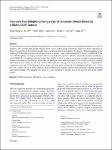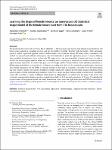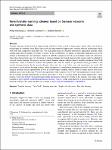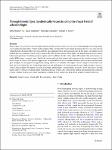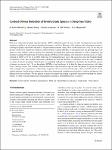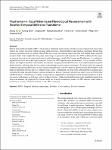Search
Author
- Jorgensen, Ed (3)
- McFadyen, Ron (3)
- Nora, El-Rashidy (3)
- Christian, Homeyer (2)
- next >
Subject
- programming (10)
- Open Access (8)
- Java (7)
- Programming (7)
- next >
Date issued
- 2020 - 2025 (293)
- 2010 - 2019 (39)
- 2000 - 2009 (2)
- 1999 - 1999 (1)
Has File(s)
- true (335)
Search Results
Intelligence agencies have identified artificial intelligence (AI) as a key technology for maintaining an edge over adversaries. As a result, efforts to develop, acquire, and employ AI capabilities for purposes of national security are growing. This article reviews the ethical challenges presented by the use of AI for augmented intelligence analysis. These challenges have been identified through a qualitative systematic review of the relevant literature. The article identifies five sets of ethical challenges relating to intrusion, explainability and accountability, bias, authoritarianism and political security, and collaboration and classification, and offers a series of recommendations targeted at intelligence agencies to address and mitigate these challenges. |
The development of neural relighting techniques has by far outpaced the rate of their corresponding training data (e.g., OLAT) generation. For example, high-quality relighting from a single portrait image still requires supervision from comprehensive datasets covering broad diversities in gender, race, complexion, and facial geometry. We present a hybrid parametric neural relighting (PN-Relighting) framework for single portrait relighting, using a much smaller OLAT dataset or SMOLAT. At the core of PN-Relighting, we employ parametric 3D faces coupled with appearance inference and implicit material modelling to enrich SMOLAT for handling in-the-wild images. |
We present the Regensburg Breast Shape Model (RBSM)—a 3D statistical shape model of the female breast built from 110 breast scans acquired in a standing position, and the first publicly available. Together with the model, a fully automated, pairwise surface registration pipeline used to establish dense correspondence among 3D breast scans is introduced. Our method is computationally efficient and requires only four landmarks to guide the registration process. A major challenge when modeling female breasts from surface-only 3D breast scans is the non-separability of breast and thorax. |
Transfer learning schemes based on deep networks which have been trained on huge image corpora offer state-of-the-art technologies in computer vision. Here, supervised and semi-supervised approaches constitute efficient technologies which work well with comparably small data sets. Yet, such applications are currently restricted to application domains where suitable deep network models are readily available. In this contribution, we address an important application area in the domain of biotechnology, the automatic analysis of CHO-K1 suspension growth in microfluidic single-cell cultivation, where data characteristics are very dissimilar to existing domains and trained deep networks cannot easily be adapted by classical transfer learning. |
Tools supporting the teaching and learning of programming may help professors in correcting assignments and students in receiving immediate feedback, thus improving the solution before the final submission. This paper describes the rDSA tool, which was designed, developed, and evaluated to support students in completing assignments concerning (i) the execution of statistical analyses in the R language and (ii) commenting on the results in natural language. |
Birds of prey rely on vision to execute flight manoeuvres that are key to their survival, such as intercepting fast-moving targets or navigating through clutter. A better understanding of the role played by vision during these manoeuvres is not only relevant within the field of animal behaviour, but could also have applications for autonomous drones. In this paper, we present a novel method that uses computer vision tools to analyse the role of active vision in bird flight, and demonstrate its use to answer behavioural questions. Combining motion capture data from Harris’ hawks with a hybrid 3D model of the environment, we render RGB images, semantic maps, depth information and optic flow outputs that characterise the visual experience of the bird in flight. In contrast with previou... |
Each year, underwater remotely operated vehicles (ROVs) collect thousands of hours of video of unexplored ocean habitats revealing a plethora of information regarding biodiversity on Earth. However, fully utilizing this information remains a challenge as proper annotations and analysis require trained scientists’ time, which is both limited and costly. To this end, we present a Dataset for Underwater Substrate and Invertebrate Analysis (DUSIA), a benchmark suite and growing large-scale dataset to train, validate, and test methods for temporally localizing four underwater substrates as well as temporally and spatially localizing 59 underwater invertebrate species. |
Given a node-attributed graph, how can we efficiently represent it with few numerical features that expressively reflect its topology and attribute information? We propose A-DOGE, for attributed DOS-based graph embedding, based on density of states (DOS, a.k.a. spectral density) to tackle this problem. A-DOGE is designed to fulfill a long desiderata of desirable characteristics. Most notably, it capitalizes on efficient approximation algorithms for DOS, that we extend to blend in node labels and attributes for the first time, making it fast and scalable for large attributed graphs and graph databases. |
Swarm intelligence leverages collective behaviours emerging from interaction and activity of several “simple” agents to solve problems in various environments. One problem of interest in large swarms featuring a variety of sub-goals is swarm clustering, where the individuals of a swarm are assigned or choose to belong to zero or more groups, also called clusters. In this work, we address the sensing-based swarm clustering problem, where clusters are defined based on both the values sensed from the environment and the spatial distribution of the values and the agents. |
Remote photoplethysmography (rPPG), which aims at measuring heart activities and physiological signals from facial video without any contact, has great potential in many applications (e.g., remote healthcare and affective computing). Recent deep learning approaches focus on mining subtle rPPG clues using convolutional neural networks with limited spatio-temporal receptive fields, which neglect the long-range spatio-temporal perception and interaction for rPPG modeling. In this paper, we propose two end-to-end video transformer based architectures, namely PhysFormer and PhysFormer++, to adaptively aggregate both local and global spatio-temporal features for rPPG representation enhancement. |


